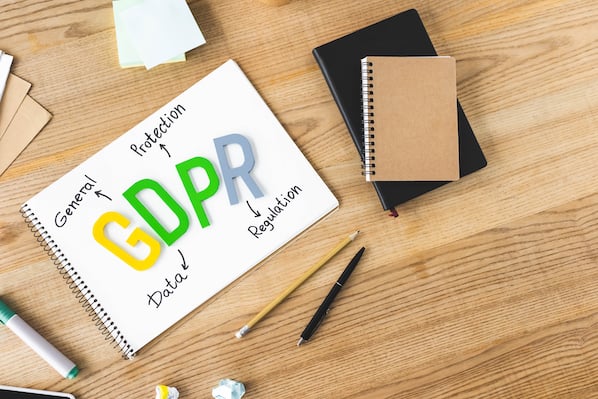5 Things Marketers Should Know About Compliance
1. Wait, What ‘Data’ is It?
As a marketer, you are probably naturally closest to a lot of the user data that your company collects. It can tell you a lot about your users or customers and it is used by teams internally to achieve sales and marketing objectives.
Unfortunately, such wide use of this data across your organization can open it up to the risk of being misused or unprotected if there are no proper controls put in place. That's why it's best to put structures in place to keep this data organized, audited, and secure.
Taking stock of the various data sources that are across your company and how they interact with software and systems is essential.
Using this intel allows you to create a lock-tight plan to maintain consistent data structures and implement necessary changes, whilst giving you the ability to pivot as the business expands.
Maintaining an audit trail of data records is paramount in order to be able to respond to any requests by regulatory bodies. Using automated software to sync system logs and less reliance on excel sheets is by far the best way to manage large data sets and produce reports upon request. Using machine learning to scan and catalog data assets across the enterprise helps you better understand your data so you can derive more value from it.
2. Compliant Data Collection and Use
Most businesses are in the habit of collecting data on their customers, but you must remember that these ultimately belong to them, and not so much you!
A person is merely choosing to share their data with you with the expectation that you will keep their interests safe. Each individual needs to always be informed as to its intended use.
This information is contained in your privacy policy which should be under constant review and if you make changes to this, you are obligated to inform every individual within its purview. Not only that, a person may choose to request and withdraw their data at any time, which you are also obligated to comply with. Having your data organized in tenets as described above and having systems in place that can extract and delete this data are crucial in order to respect your customers’ wishes.
Compliance tools have been developed with these requirements in mind. Using systems that run with precision and reliability, that are flexible and can scale with you as you grow, gives you the ability to adapt to change and be compliant without having to build a bespoke system or rely on pesky excel sheets.
3. Create a Compliance Team
Organizations large and small benefit from having a multi-disciplinary team focussed on compliance who are scattered across various company activities. It is no longer just a siloed issue for one person or team to solve. Undoubtedly, if a marketer needs some help from a web or tech colleague, it can often be difficult to get assistance from them if compliance is not high on their priority list too.
Each member has the benefit of knowledge in their own specialism, which can only be of benefit if shared. For example, a tech manager's responsibilities could include knowing how data sets across the org are structured and how compliance controls should be implemented. They need to ensure a marketer is equipped to do their job using data housed in compliant and secure systems.
Partnering with your legal team on marketing initiatives means you are working together to achieve creative objectives in a compliant manner. Without access to these subject matter experts, who have in-depth knowledge of compliance matters, especially as they change in other jurisdictions, makes it difficult to achieve business goals and can cause roadblocks. Using compliance software to connect these teams/individuals can help a team collaborate on initiatives in a more efficient way.
Building a team that can make compliance a priority and work together on an ongoing basis to maintain and adapt data governance principles is key for success.
4. Create Compliance Checks and Internal Data Governance
With data processes being managed across organizations, it can often be difficult to ensure a cohesive environment when it comes to compliance practices.
Therefore, it’s important to put guardrails and processes in place to mitigate risk by ensuring all employees are up to date on internal data management practices and checks in place to improve these processes. Ensuring regular training is provided is an easy way to meet your due diligence in this regard. Use an LMS for the best compliance training courses. After all, data management is everyone's responsibility, with any misuse resulting in it being costly to the company.
Managing and controlling brand cohesion across all of your marketing content channels including digital, print, and social media is a no-brainer.
Assessment of future campaigns will allow you to anticipate potential compliance issues at an early stage. Maintaining this consistency across partner and co-marketing content campaigns ensures any legal requirements can be followed. Documenting data collection and management practices for different teams is essential and the provision of regular updates can be helpful as the law continues to evolve in different territories where your customers might do business from.
It’s also very important that each employee knows who to contact with any urgent request as they may be in a customer-facing role where an aggrieved customer may require an urgent response to a grievance with their data. Such requests can be time-sensitive so being able to escalate sensitive issues to a representative needs to be made an easy task in order to avoid any potential regulatory enforcement that could ensue for not responding to an issue within a defined window.
5. Monitor Global Privacy Regimes and Incorporate Changes
You may have noticed that privacy is now top of mind for many countries with local approaches to privacy being spun up on the daily.
Largely following the regulatory aspects that flow from the GDPR and the E-Privacy directive, territories are now adapting, and are seeking to uphold and respect the privacy of each individual. With that, it’s important to know what applies to you.
While you may think that something like the GDPR has no bearing on you or the privacy of your customers because you are not based in the EU, this couldn't be further from the truth.
The GDPR is applicable to where you may have users or customers and so being able to meet the privacy needs of individuals in those areas is required.
Whether it is adapting cookie management for web/application use or making sure that your communication to your DACH customers is compliant using a double-opt-in email, it is essential to keep abreast of the regulatory requirements when you develop your marketing initiatives. Consideration needs to extend to local laws also if you are expanding your reach into new territories.
Knowing what is compliant in a new territory should be top of mind in this case as no territory is the same with regards to their approach to marketing compliance. Creating a compliance strategy and working closely with your legal and wider compliance team is vital to achieving your objectives.
Regulatory guidance is constantly evolving, so making sure you are consistently evaluating and meeting the requirements of different jurisdictions — it’s a full-time job.
Final Thoughts
When implementing marketing compliance into your company it’s important to treat it as a key priority for your business. As marketers continue to fight for creativity but are hindered by compliance, it is challenging to strike a balance between the two.
Having a detailed understanding of applicable compliance rules and best practice techniques makes a marketer a valuable asset to any company. Being able to have foresight into potential compliance challenges early on in developing your marketing initiatives is powerful, and can lead to more effective decisions.
More than ever, brand integrity has become a cornerstone for companies. Showing your users that you are serious about marketing compliance and respecting their privacy will set you apart from your competitors.

.jpg)






![Is This Copyright Infringement? What Images You Can & Can't Share [Infographic]](https://53.fs1.hubspotusercontent-na1.net/hubfs/53/sharing-is-caring.jpeg)

